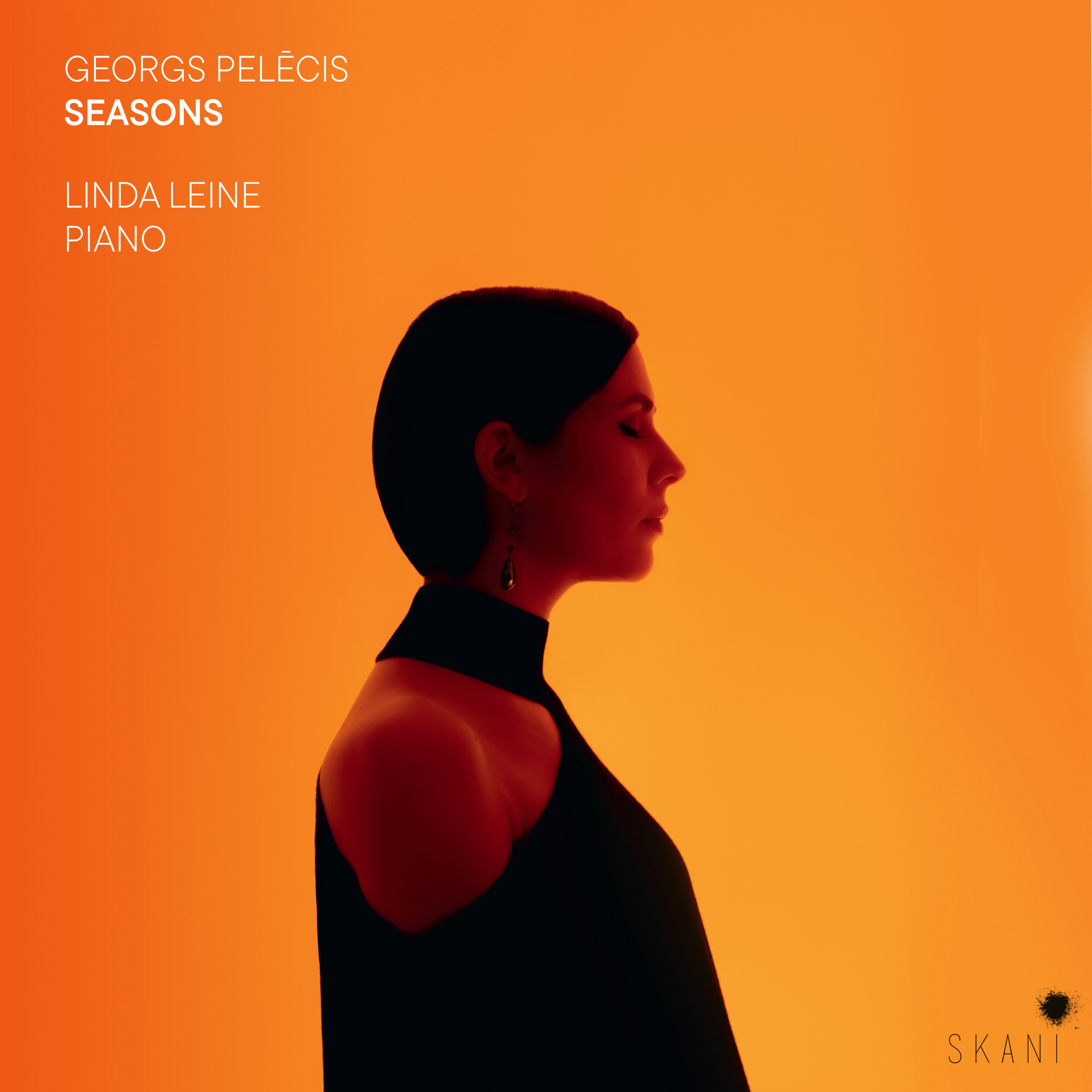Quietly and gradually, composer Georgs Pelēcis has become one of the best known and beloved composers from Latvia. His music has been listened to millions of times on streaming services, entrancing listeners all over the world with its seeming simplicity, but with rich melodies and emotional depth. With early music being a major influence, his works often echo themes and musical ideas from the Baroque and Renaissance eras.
Among his works for piano, a notable entry is the Gadalaiki (Seasons) cycle, a six-work cycle (the four seasons plus two additional works relating to the New Year), composed over the course of more than forty years, and the entire cycle comes to be about one hundred minutes of music. Latvian pianist Linda Leine’s recording of all the entries in the Gadalaiki cycle was released in 2022.
Each of the works in the cycle is a larger form work (each work is between fifteen to twenty-five minutes in length), which allows for Pelēcis to fully develop and expand the melodic themes in each piece, providing for an immersive listening experience for the listener.
The cycle begins with ‘Jaungada mūzika’ (New Year’s Music), which begins gently, almost deliberately, sounding much like a formal dance, but then gradually starts gaining in energy and tempo. The work, the first to be composed in the cycle (in 1977), perhaps most exhibits his Renaissance and Baroque influences (conjuring a New Year’s celebration from that era), and the work gently flows from celebratory sounds to more contemplative melodies, and pianist Leine’s performance brings forth the needed delicateness and precision.
A sense of trepidation fills the opening minutes of ‘Pavasara mūzika’ (Spring Music), perhaps to evoke a wintry landscape prior to the arrival of spring. Then the solemn and melancholic mood, over time, begins to include more positive elements, while still retaining a somber atmosphere, and Leine deftly reveals the many aspects of this work in her layered performance.
The longest work in the cycle is the twenty-five minute ‘Vasaras mūzika’ (Summer Music), and throughout its expansive runtime, it creates a vivid panorama of summer, replete with both blissful warm days as well as summer storms. Adeptly moving between the moments of tension and delicate reflection, Leine brings out the many vivid colors in the work.
The somber ‘Rudens mūzika’ (Autumn music) then leads into the pensive, placid ‘Ziemas mūzika’, which builds to a resounding, joyful crescendo. The cycle then concludes with a return to the New Year – ‘Jaunais gads atkal klāt’, written more than forty years after the initial work in this cycle. Retaining the celebratory atmosphere of the earlier work, Pelēcis continues to bridge the centuries in his music, and Leine, with both precision and emotion, completes this musical journey through the year.
Some listeners may find the music to be a bit too calm, though there are occasional moments of fire and energy, the bulk of the music is in a meditative, reflective style. Certain themes may be repeated possibly a few too many times, so there is the occasional sense that Pelēcis could potentially have trimmed some of the works. However, perhaps that is part of the charm of Pelēcis’ music, that these repeated, deceptively simple themes give his works a dream-like quality, like a leisurely, lengthy walk during each of the seasons.
Beautiful, haunting, affecting are all words that could be used to describe the music of Georgs Pelēcis, and it is perhaps no surprise that his music has found many sympathetic ears and has moved listeners all over the world. Full of not just melodic beauty, but also spiritual positivity, Pelēcis’ music has a singular richness and resplendence. Pianist Linda Leine’s skills with melody, deep appreciation of the music and attention to detail makes Gadalaiki a rewarding musical journey.
Egils Kaljo,
05/02/2024, www.latviansonline.com
_________________________
Since the time of the lockdown was not easy for her and she was looking for a project, she sought contact with her compatriot Georgs Pelēcis (born 1947) and asked him which of his piano works he would most like to have recorded on CD, explains the Latvian pianist Linda Leine, who lives in Germany, in the promo video. She was then happy that he suggested his cycle "Gadalaiki" (Seasons), completed in 2021 and hugely dimensioned at around 100 minutes of playing. In Pelēcis' world there are not only four, but five seasons: The cycle begins with "New Year's music" and ends with "New Year is here again". But that is almost the most original thing the work has to offer. For despite all the assurances on the part of the composer ("All my creative inspiration comes from euphony as a reflection of the ideal or the embodiment of a homeland") and the booklet text writer, who enthuses about the "new simplicity", the "new consonantism" of the music and celebrates - in capitals - its EUPHONY, Pelēcis' Seasons offer nothing more than a pretty, decorative wallpaper of sound with a tendency towards ambient music over long stretches. The seasons still seem to be intact in Latvia and not threatened by the climate crisis: Spring as "anticipation" (booklet) of a beautiful, warm summer with its "also misty veiled infinity", followed by a "pleasant poetic autumn feeling" and, yes, a really cold winter "like it used to be", to paraphrase Rudi Carrell himself now. What could not have been done with a cycle of seasons in 2021? It is certainly not due to Linda Leine's highly committed acting that a lot of potential was wasted here.
Music *** Sound ****
Burkhard Schäfer
FONO FORUM, 02/2023
______________________________________
Der Komponist Georgs Pelecis wird in Lettland zurecht verehrt und ist ein wichtiger Vertreter zeitgenössischer Musik. Doch er ist in Deutschland leider weniger bekannt. Sein Werk enthält Sinfonien, Kammermusik sowie Chormusik. Berühmte Interpreten wie Gidon Kremer und Alexei Lubimov haben sich für sein Werk engagiert. In diesem Jahr feiert er seinen 75. Geburtstag. Deswegen hat die ebenfalls aus Lettland stammende Pianistin Linda Leine ein Doppelalbum aufgenommen, das in wunderbarer Weise mit Pelecis‘ Musik bekannt macht. Er sei schon immer fasziniert gewesen von diesem intelligenten Prinzip der Wiederholung von Zyklen, das der ganzen Welt, der Natur und der menschlichen Existenz zugrunde liege, so Pelecis‘. Seine Musik ist minimalistisch, klar, lebhaft und festlich. Aber sie kann auch einfühlsam, leise und voller Licht sein. Das alles macht Linda Leine auf diesem besonderen Album deutlich. Mit Anklängen an das Barock und das Treiben eines Jahrmarkts lässt die „Neujahrsmusik“ aus dem Jahre 1977 grüßen. Quintparallelen und Staccato-Effekte vermitteln eine abwechslungsreiche harmonische Stimmung. Auch Moll-Anklänge sorgen hier für interessante Klangfarben. Das Loslassen des metrischen Rhythmus‘ überrascht den Hörer immer wieder neu. Bei der „Frühlingsmusik“ (2021) fehlt die ständige Aufregung und Verzierung. In den Moll-Tonarten findet man Melancholie, Nachdenklichkeit – aber auch ein Gefühl von Weite. Es kommt zu einer überraschenden Auflösung von Räumlichkeit und akustischen Grenzen. Es ist eine musikalische Meditation. Die „Sommermusik“ (2017) ist ebenfalls sehr geräumig und von der emotionalen Farbe e-Moll beherrscht. Sie behauptet ihre diatonische Struktur in e-Moll als auch in a-Moll. Es ist ein klingendes Aquarell. Bei der „Herbstmusik“ (2011) überwältigt der weite melodische Rahmen, den Linda Leine sehr einfühlsam auskostet. Oktavsprünge und Achtelnoten überraschen den Zuhörer. Die effektvolle „Wintermusik“ aus dem Jahr 2015 vermittelt das erhabene Bild einer Prozession. Ein zaghaftes D-Dur lässt eigenartige klangliche Bewegungen folgen. Und ein Marschrhythmus gibt dem Ganzen dann eine erstaunliche Wende. „Neujahr ist wieder da“ heißt es in der letzten Komposition aus dem Jahr 2018. Hier kommt es gleich zu Beginn beim Agitato zu einer freudigen Erregung. Auch die schwungvollen Klänge eines Tanzes sind herauszuhören. Es gibt Reminiszenzen an die Klangwelt Georg Friedrich Händels. Ein helles B-Dur bleibt die zentrale Tonart des gesamten Werkes. „Mir fällt kein anderer klassischer lettischer Künstler ein, der ein solches Gefühl der Ordnung und Ruhe vermittelt“, meint Reinis Birznieks. Dem ist nichts hinzuzufügen.
ALEXANDER WALTHER
12/11/22
www.onlinemerker.com

